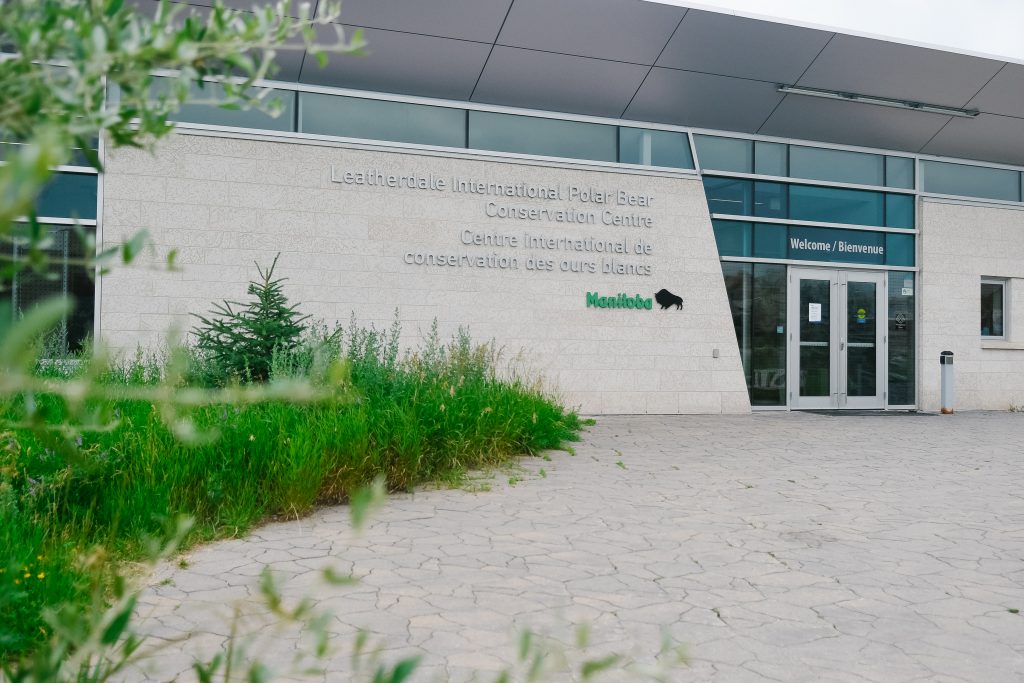With hesitation, we rounded the corner into the first exhibit of the Canadian Museum for Human Rights. I was nervous about bringing my son and introducing him to heavy topics that often surround human rights. What hard conversations were ahead of me, was I prepared? Is The Canadian Museum for Human Rights family friendly? And while I had done my research, what was it going to be like actually here at the museum?
The swirling nerves quickly subsided as I was welcomed into an interactive, bright, and hands-on museum designed for visitors of all interests and ages. “You’re never too young to learn about human rights” was the slogan on the website and I was inspired by how the museum transformed difficult stories into examples of hope for children to follow. I also loved how they showcased champions of community, and how the power of small actions can help create positive change.
Here’s a detailed guide on how to plan your own family visit to the Canadian Museum for Human Rights and will help answer the question that many parents have: Is The Canadian Museum for Human Rights Family Friendly?
The Canadian Museum for Human Rights
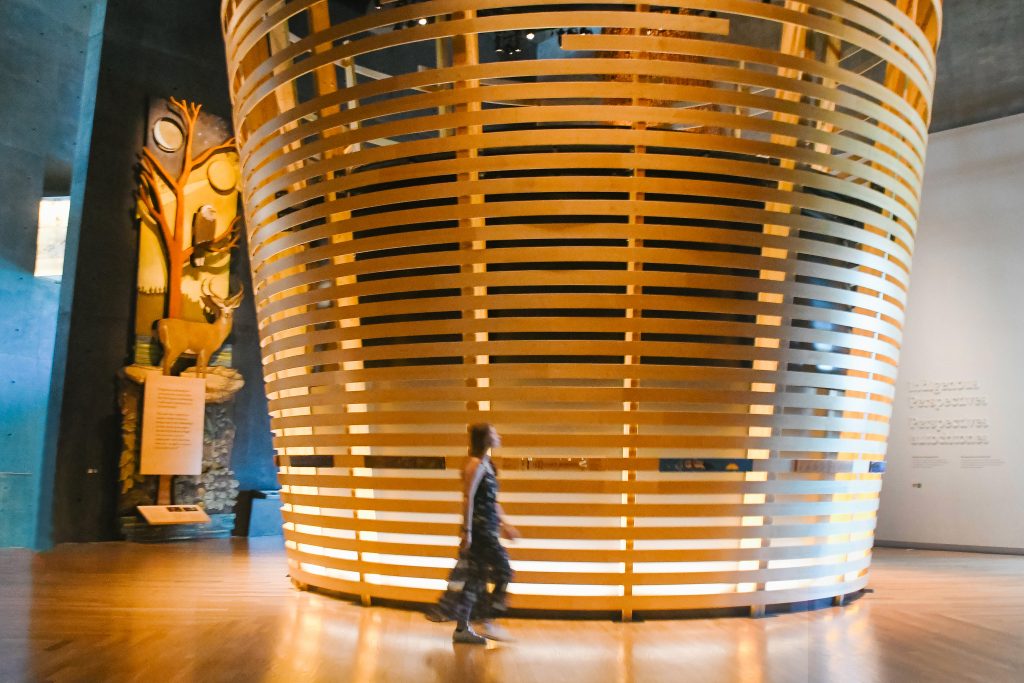
The Canadian Museum for Human Rights is an award-winning, world-class museum located at The Forks in downtown Winnipeg, Manitoba. Opened in 2014, the $351-million facility is a partnership between the Government of Canada and the Asper Foundation, founded by the late Israel Asper, a Winnipeg entrepreneur and philanthropist who believed deeply in human rights and passing on their importance of them to future generations.
The museum is committed to being family-friendly, with a comprehensive website full of information for families. Admission, as of July 2022, is $18 for adults, $8 for youth 7-17 years, and free for kids 6 and under. Family admission for two adults and up to four children is $47. The museum is typically open Tuesday to Sunday, 10 a.m. to 5 p.m., except they are open Fridays until 9 p.m. Strollers, baby change tables and water fountains are available, and a nut-free and scent-free environment is encouraged. The museum is fully accessible, and there is a café for snacks and meals.
Is the Canadian Museum for Human Rights Family Friendly?
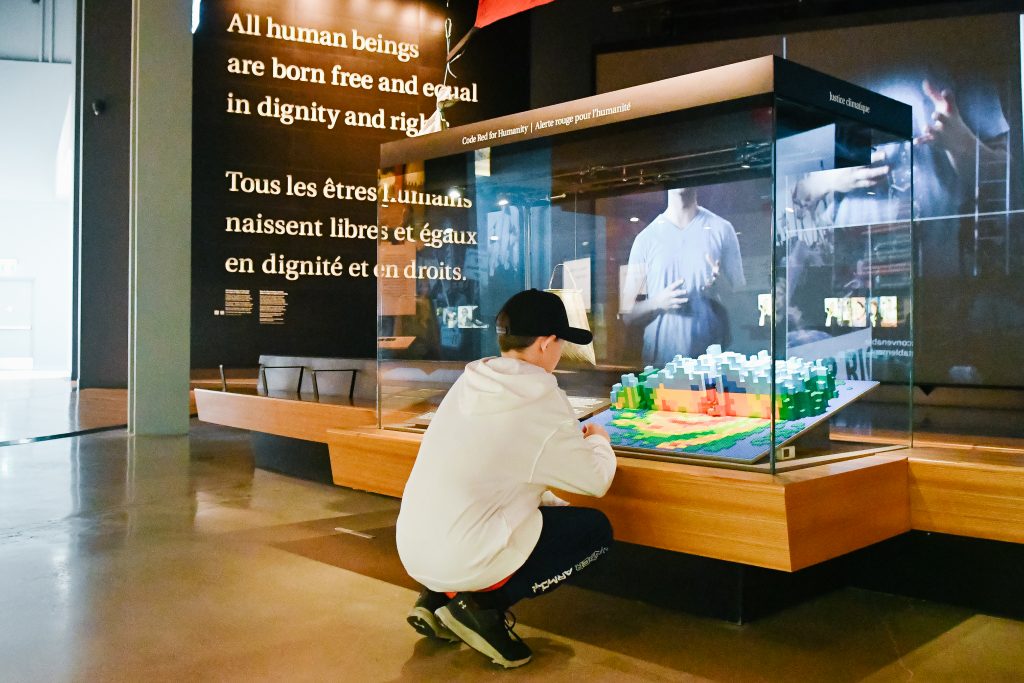
Is the Canadian Museum for Human Rights family-friendly? This is the question you may ask yourself before you and your family travel to the Canadian Museum for Human Rights. After all, the Canadian Museum for Human Rights exists because it needs to exist. Because the sad reality is that human rights, while universal, are not universally accessible. Crimes against humanity continue to be committed every day. What will my kids be exposed to and how will I, as a parent, handle it? I, too, had these questions before our visit to the Canadian Museum for Human Rights. And while I may not have all the answers, I can share my family’s experience. Here is our guide to planning your visit to the Canadian Museum for Human Rights with your family.
A Guide For Planning Your Visit
BEFORE YOU GO
“What is genocide?” my son asked, as he walked along a display wall at the Canadian Museum for Human Rights. How am I supposed to answer that?
The Holocaust in German-occupied Europe, The Holodomor in Ukraine, the Armenian genocide, the Rwandan genocide, the Bosnian ethnic cleansing – the list of horrors sent shivers down my spine, not only because of the massive numbers of people that died but also because of the look on my son’s face, as he began to understand what people had done to other people.
Was it a huge mistake to expose my kids to these realities? This was the question that swirled in my mind, as we wound our way up through the museum’s seven levels, toward the 100-meter-high Tower of Hope.
If I had taken the time to browse the excellent Children and Families section of the Canadian Museum for Human Rights website, I wouldn’t have been so blindsided by my son’s question. Before you go to the museum, I strongly suggest you read through the provided materials and questions and have a chat with your kids about human rights. It doesn’t have to be super serious, but rather a quick heads up that they are going to a museum that is unlike anything they may have been to before. This also provides you with the opportunity to skip past exhibits (like the Holocaust) if you feel it is too sensitive of a topic for your child at that age).
DURING YOUR VISIT
From Darkness to Light

I have to start with the museum building itself – your kids will love it. Designed by architect Antoine Predock, the 24,155 square meters architectural marvel is loaded with human rights symbolism, or more importantly, if you are a kid, oodles of space to run around in. An 800-meter long series of crisscrossing illuminated ramps lead you from the dark first floor up through the twelve galleries and seven levels to the base of the corkscrew stairs that lead to the tower lookout. Did I mention that the tower and the entire southwest aspect of the building are encased in over 1,600 panes of glass? This journey from the lower levels of darkness to the upper tower of light is deliberate and represents the continuing struggle for human rights from a dark past to a brighter future. There are some incredible views and a few spots where my kids tested each other’s fear of heights. I can honestly say I have never been in a more stunning and thoughtfully designed building.
Built for Kids
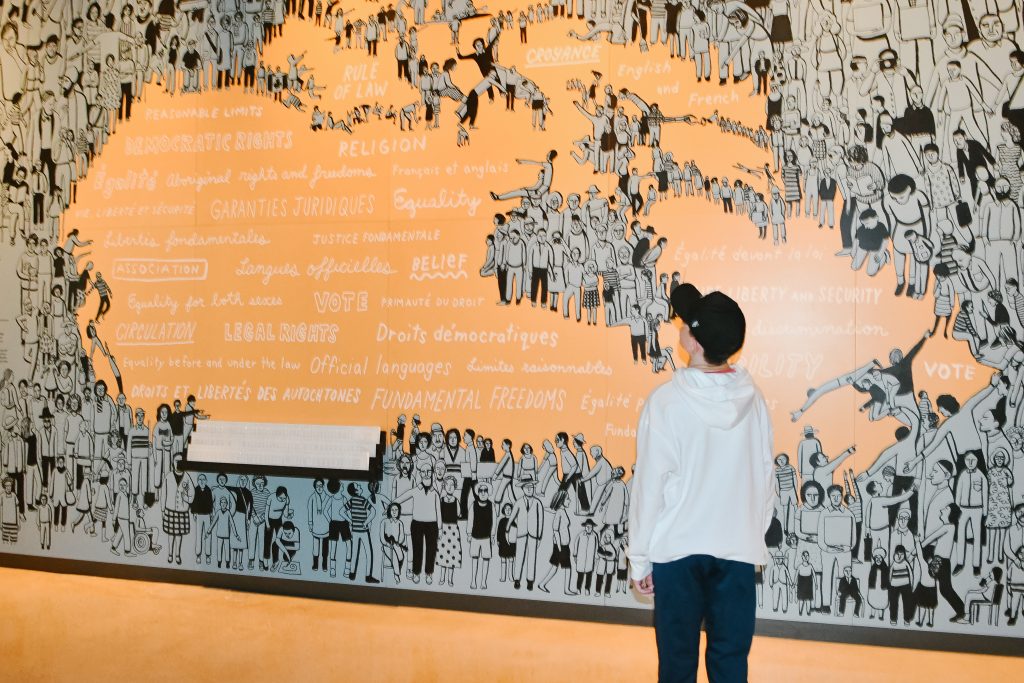
The entire museum was built on the dream of Israel Asper to educate children and young adults on the importance of human rights. As such, young people are not an after-thought, they are the very reason for the museum’s existence. School tours are available, along with supporting educational materials. The museum is aware that some content may be difficult for children, and they have parental tips and suggestions for guiding discussions with your child and helping them navigate their emotions. Helpful guides suggesting pathways and exhibits for various age levels are available on the CMHR website. I can’t describe everything that is kid-friendly in this article, but I will highlight a few of our favourites, listed by the gallery in which they can be found.
Indigenous Perspectives Gallery: A 360-degree circular theatre shows a family-friendly film, narrated in part by a young girl. The film presents the Seven Sacred Teachings – love, courage, humility, honesty, wisdom, truth, and respect.
Canadian Journeys Gallery: A motion sensor light game is sure to be a hit with the kids. We spent a good fifteen minutes here, chasing each other around the large floor area to merge our individual lights into a more powerful and dramatic union, symbolizing the strength of cooperation and inclusion.
Actions Count Gallery: An interactive digital table enables players to play out scenarios, such as bullying at school, and making choices as on-screen animated characters.
Rights Today Gallery: A display of everyday items, such as plastic bags and cell phones, encourages children (and adults!) to think about how such items are connected to human rights issues worldwide.
Inspiring Change Gallery: Markers and blank cards are available for children to write a message or create a drawing about human rights to display for everyone to see. Interactive music stations with headphones are also available to listen to music with human rights-based themes.
Gallery Guide by Age
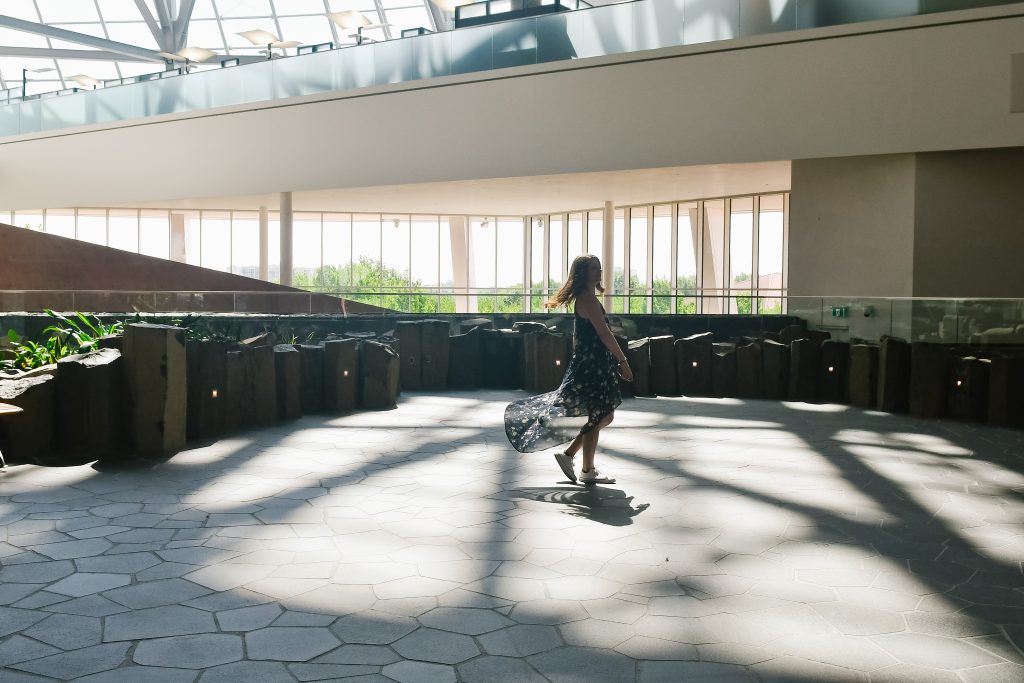
The museum website offers Guides for Exploring for children by age group. These guides suggest pathways through the museum that offer age-appropriate material for kids. The website gives more detail, but here is a quick run-down on each age group.
Children Under 7
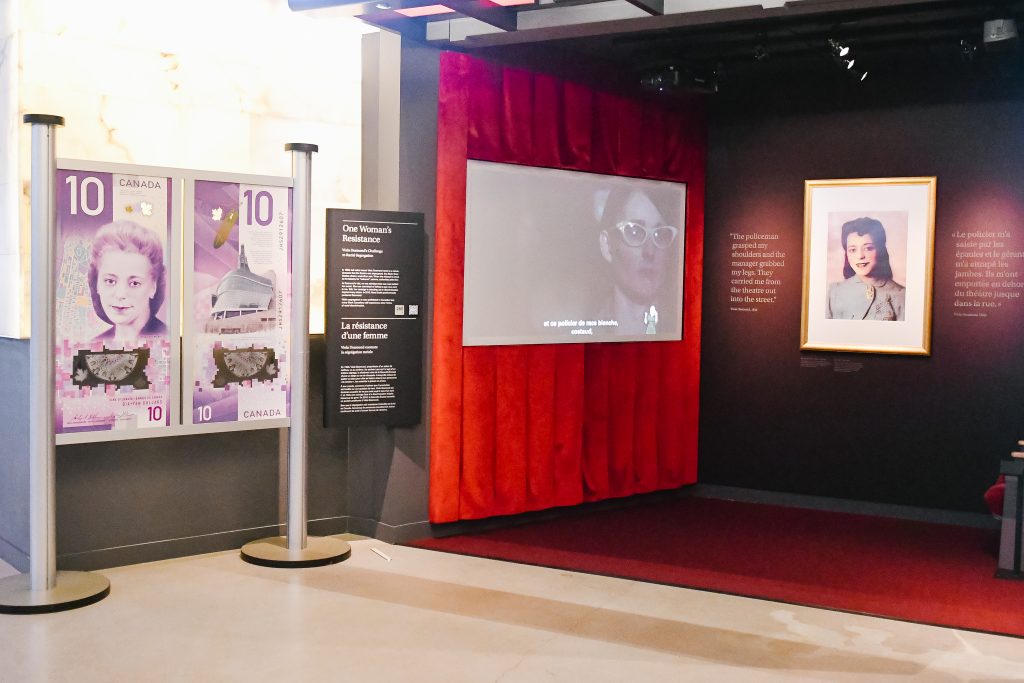
This guide suggests the following galleries and activities for kids under 7:
- Level 1: Bonnie & John Buhler Hall, Welcome Wall and human foot cast
- Level 2: Indigenous Perspectives, circular theatre, Métis beadwork sample
- Level 2: Canadian Journeys, Lights of Inclusion game (this was a huge hit with our kids!)
- Level 3: Stuart Clark Garden of Contemplation, relax and take a break in this beautiful garden
- Level 5: Rights Today, Everyday Objects display
- Level 7: Inspiring Change, Imagine Card display – become part of the museum!
- Level 7: Israel Asper Tower of Hope, to the top of the world! Well worth the climb!
Children 7 – 12

This guide suggests the following galleries and activities for kids 7-12:
- Level 1: Bonnie & John Buhler Hall, Welcome Wall and human foot cast
- Level 2: Indigenous Perspectives, circular theatre, Métis beadwork sample
- Level 2: Canadian Journeys, Inclusion Lights game, One Woman’s Resistance, Inclusion for All, Escape from Oppression, Banned from the Ballot
- Level 3: Protecting Rights in Canada, Map of Canada / 1982 Canadian Charter of Rights and Freedoms
- Level 3: Stuart Clark Garden of Contemplation
- Level 4: Turning Points for Humanity, John Peters Humphrey’s story and the first draft of the Universal Declaration of Human Rights, digital books on Children’s Rights
- Level 4: Actions Count, It’s Your Choice –– a multi‐player, role‐play game that asks you to make choices about scenarios using animated characters
- Level 5: Rights Today, Everyday Objects display, stories of Canadian human rights defenders (Buffy Sainte‐Marie, who spreads messages through music and education/Craig Kielburger, who started working for human rights at age 12)
- Level 7: Inspiring Change, Imagine Cards
- Level 7: Israel Asper Tower of Hope
Teens 13 – 18
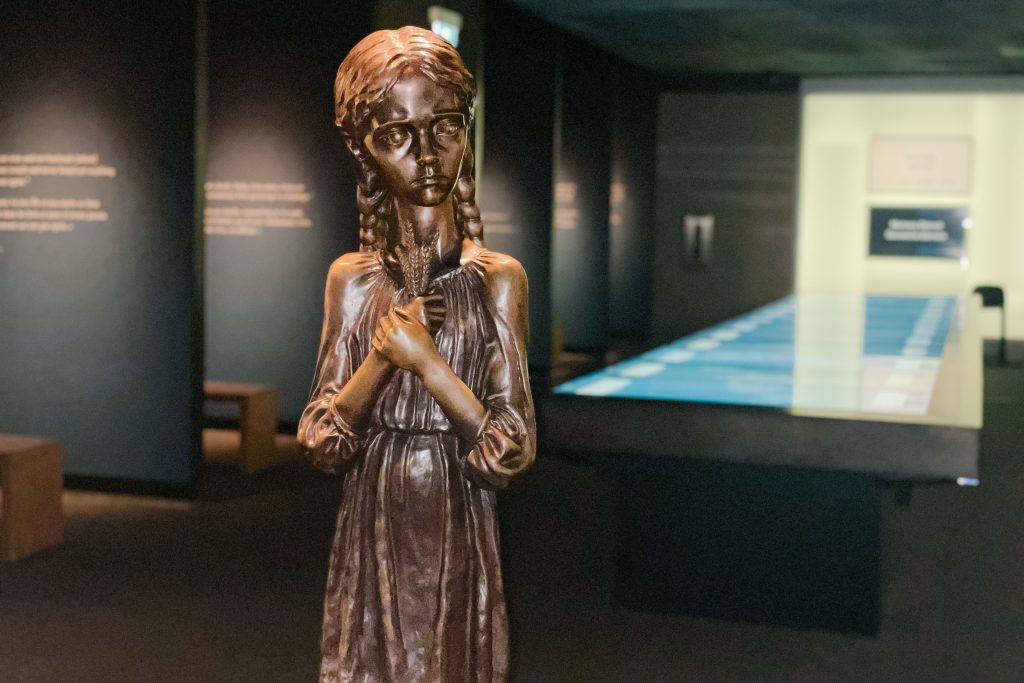
This guide suggests the following galleries and activities for 13-17 year-olds:
- Level 1: Bonnie & John Buhler Hall, Welcome Wall and human foot cast
- Level 2: Indigenous Perspectives, circular theatre, Métis beadwork sample
- Level 2: What Are Human Rights multimedia show
- Level 2: Canadian Journeys, theatre (Canadian Human Rights Journeys and Childhood Denied: Indian Residential Schools and their Legacy), Lights of Inclusion game
- Level 3: Protecting Rights in Canada, Rights in the Courts interactive table/voting
- Level 4: Turning Points for Humanity, digital books videos (Tears for Justice)
- Level 4: Breaking the Silence, atrocities denial map, film (Holodomor: Memory Eternal)
- Level 4: Actions Count, Your Choice multi‐player, role-playing game on an interactive table
- Level 5: Rights Today, Films (cyber‐bullying and representations of women in media)
- Level 7: Inspiring Change, Music Listening Stations (soundtrack of human rights struggles)
- Level 7: Israel Asper Tower of Hope – I added this one because it is a must for all ages!
Thoughtful Technology
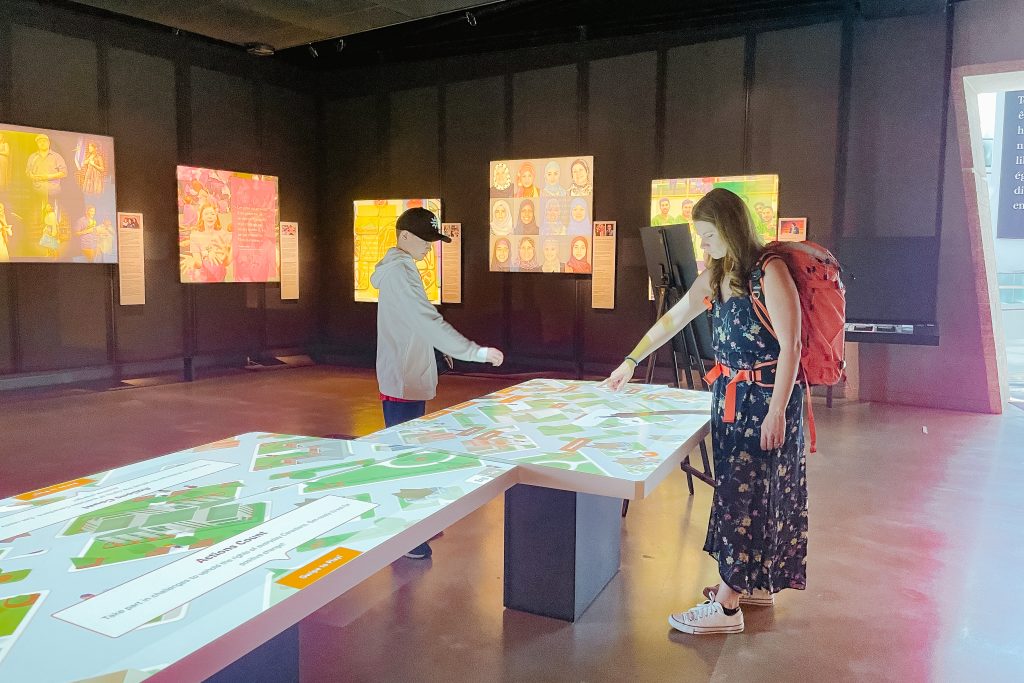
The thoughtful incorporation of technology within the museum enriches the experience of visitors, both old and young. A mobile app (CMHR in Apple App Store or Google Play), the first of its kind for any museum in the world, is a free app that includes many engaging features, including a self-guided audio tour, a “Near Me” mode that activates content on your phone when you are in close physical proximity to over 120 access points within the museum (designed specifically for those with low vision or blindness), an augmented reality panorama that overlays landmarks in real-time while you are on the viewing platform in the Tower of Hope, a “mood meter” to share your feelings as you move through the museum, and an interactive map to help your find your way. Additionally, many of the exhibits contain interactive technology components – for example, my son enjoyed controlling a virtual earth and zooming in to learn about human rights issues in various countries around the world.
Joining the Conversation

At the end of your visit, you’ll be invited to join in the conversation by taking some time to reflect as well as write out some thoughts based on that experience. I wrote, “I will never stop believing in the power of good.”
AFTER YOUR VISIT
After your visit to the Canadian Museum for Human Rights, your child may have questions. Make time to be available for them. The Canadian Museum for Human Rights website offers additional thoughts, activities and questions for your kids after your visit to help facilitate discussion and to help your kids better integrate their visit with their understanding of the world. And my personal suggestion? Go do something fun. Have an ice cream at The Forks or go swimming. Sometimes the best way to decompress, especially for kids, is fun and physical activity.
Is The Canadian Museum for Human Rights Family Friendly?

The short answer: Yes! The long answer? You know your kids best, and what they can and cannot handle. For younger kids, the museum is a gigantic playground, filled with hands-on, interactive displays and enough walking to tire out the most energetic child, if you so choose. The museum is designed for all ages; there are many activities that kids, no matter their age, will enjoy and that will help them gain an age-appropriate understanding of the complex issue of human rights. That said, older kids who are readers will get the most out of the museum and its cutting-edge displays. But be prepared – they will inevitably have questions about the more mature content, some of them hard, as I found out.
“What is genocide?” my son asked.
How did I explain to my son what genocide is? I explained it with the truth – the hard, scary truth that there are people in the world who lust for power and riches and will do anything to get them, or to keep them. But, just like the museum itself, I balanced that truth with another truth. The truth is that other people – good people – fought wars, held general strikes, and rose up in protest to earn the basic rights and freedoms that my kids take for granted. The rights and freedoms that I sometimes take for granted.
I am convinced that knowledge and hope are powerful forces. Not just the knowledge that horrific things happened, but the knowledge that people rose up and stopped them from continuing to happen. Not just hope for a better future, but hope that our actions, here and now, can and do make a difference. That is the message I took away from the Canadian Museum for Human Rights – that human rights are an ongoing journey, from darkness to light, and that we participate in the journey, in ways both small and large. And in that knowledge, there is great hope.
Was it a mistake to explore the Canadian Museum for Human Rights with my kids? Absolutely not. Was it easy? Absolutely not. I don’t like to see my children struggle with hard realities any more than any other parent. But my kids left the museum with a much deeper sense of the privilege they live within, and what that privilege cost others to earn. They also left knowing that they have power and that their actions can literally help change the world. These are lessons worth a hard conversation, some deep reflection, and maybe some tears. And, as you probably guessed, I’m not just talking about the kids.
Canadian Museum for Human Rights FAQs
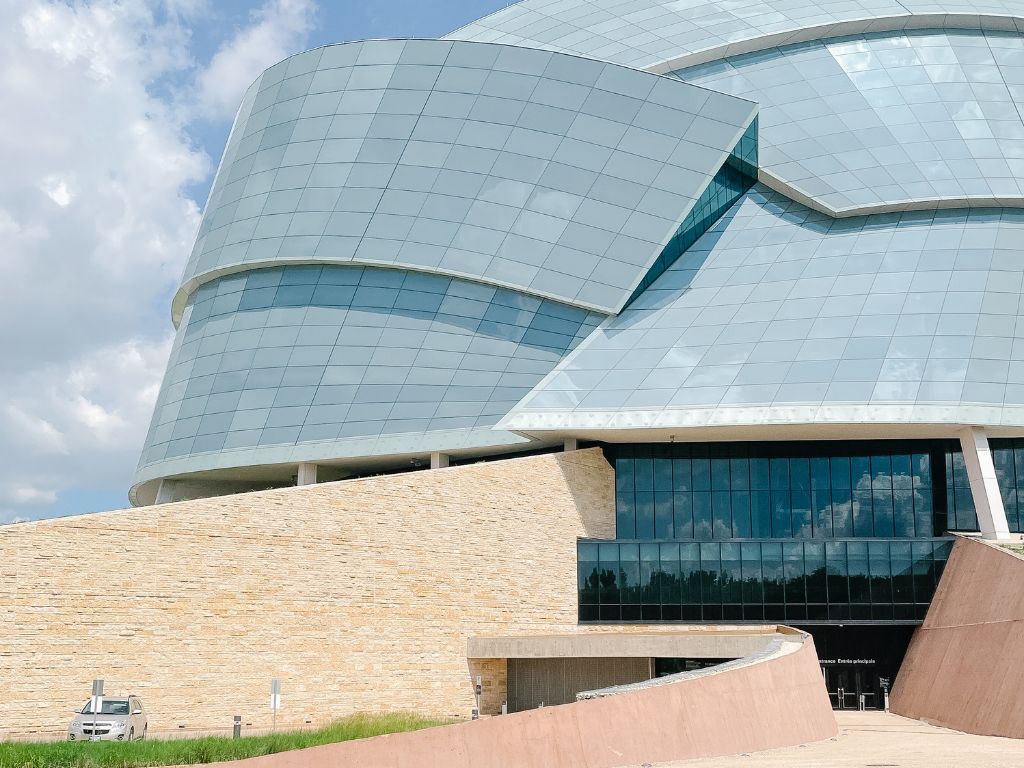
Who built the Canadian Museum for Human Rights?
The museum was built by a partnership between the Government of Canada and the Asper Foundation and designed by architect Antoine Predock
How tall is the Human Rights Museum?
The top of the Tower of Hope is 100 meters tall.
What exhibits at the Canadian Museum for Human Rights are family-friendly?
Check out the Guides for Exploring, an age-based guide for visiting the Canadian Museum for Human Rights with kids.
Why is the Human Rights Museum important?
Human rights are essential to a fair and safe world. But they are not a given. The museum helps to ensure that young Canadians are educated on how they can play a part in promoting human rights locally and globally.
Who owns the Museum of Human Rights?
The Government of Canada, in partnership with the Asper Foundation, owns the Canadian Museum for Human Rights.
How long did it take to build the Canadian Museum of Human Rights?
It took four years to build the Canadian Museum for Human Rights.
Google Reviews from other Families:
“I am moved. This museum found a way to deeply add emotion into all the exhibits. Within 10 minutes of engulfing myself into the stories and history, I was overcome with shivers and tears. From the gorgeous architecture, eye-catching art, to the interactive displays and story-telling, I give this museum a 6 out of 5. Our Canadian history, though filled with darkness, moves toward the light of inclusivity and positive action. Not only will I be recommending this place to all, but I will be coming back to spend more time on the newly added exhibits. You could easily spend 4+ hours here, though we only stayed for two. The employees are wonderful people that genuinely care about how you are feeling. While going through the museum, we were asked a few times how we were doing. One particular employee stroke up an empathetic and interesting conversation with us that left my heart filled with love and hope. Thank you for this incredible experience.” ~R. Wiebe
“Incredible displays of the atrocities and human rights history. Highly recommended. The architecture of the building is also breathtaking.” ~N. Doherty
“Everyone should visit this place. The building itself is amazing. The stories within are heartbreaking yet you’ll leave with hope in your heart.” ~G. Warner
“Truly an amazing experience. The exhibits were excellent, and the architecture is absolutely stunning. A must-see in Winnipeg.” ~H. Young
Looking for other adventures and experiences while visiting Manitoba? Check out these articles:
Disclosure statement: While the Canadian Museum For Human Rights invited us as guests to share this experience the views expressed are our own.



